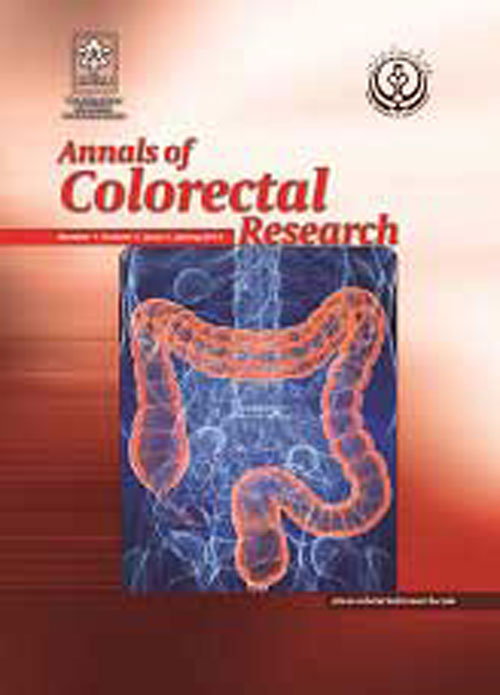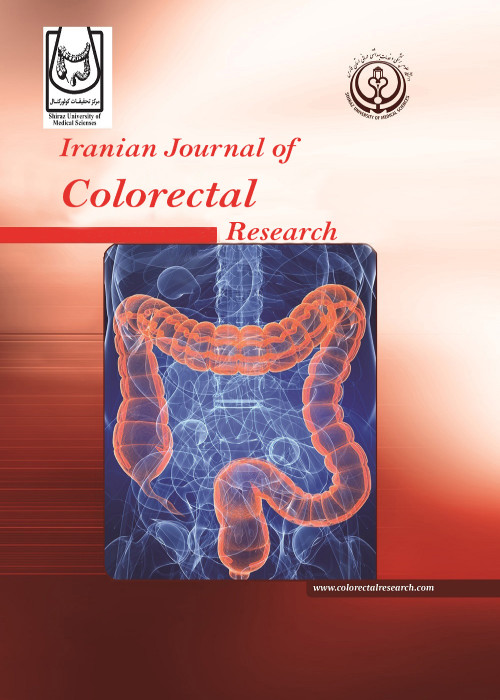فهرست مطالب

Iranian Journal of Colorectal Research
Volume:9 Issue: 4, Dec 2021
- تاریخ انتشار: 1400/11/02
- تعداد عناوین: 8
-
-
Pages 125-143Aim
Colorectal cancer (CRC) survivors experience persistent late effects of treatments, including a range of symptoms and functional impairments. There is limited evidence on the prevalence of such problems in CRC survivors. We conducted a systematic review to synthesise the evidence on the range and prevalence of patient-reported symptoms and functioning impairments experienced by CRC survivors in the acute and long-term period following their primary treatment for CRC.
MethodWe searched MEDLINE, Embase, Pubmed, Cochrane electronic databases (from 2000 to April 2021) to identify studies reporting longitudinal prevalence (i.e. a minimum of two assessment time-points) of any patient-reported outcomes (PROs) at 12 months or more since treatment. Two reviewers independently screened and extracted data on study characteristics and PRO prevalence. PROs were synthesised descriptively across time-points, from baseline before treatment, during treatment and up to 3-years post-treatment to determine prevalence of PROs over time and the extent of persistent problems in long-term post-treatment survivorship.
ResultsOf 5587 studies screened, 29 met eligibility and were included. Three years after primary treatment, up to 55-65% of colon cancer survivors reported issues with mobility and 40% reported pain and discomfort. Fecal incontinence was reported by up to 83% of rectal cancer survivors. High prevalence of problems with sexual and urinary function were also reported.
ConclusionPersistent late effects of treatment, assessed with validated patient-reported measures, should be screened for early in post-treatment survivorship to detect problems and refer to appropriate management strategies to reduce symptom burden and improve quality of life of CRC survivors.
Keywords: Bowel cancer, Systematic review, Treatment effects, Patient-reported outcomes, Survivorship -
Pages 144-148Background & Aims
Inflammatory bowel disease (IBD) is closely associated with primary sclerosing cholangitis (PSC), an uncommon chronic and progressive cholestatic liver disease. Liver transplantation (LT) is the only therapeutic strategy for PSC that may also affect the IBD course. Considering the lack of any systematic review and pursuing debate on the alterations in the clinical course of IBD after LT compared to before, we aim to systematically assess the frequencies of patients with "improved", "unchanged", or "aggravated" IBD course following LT and conduct a meta-analysis.
MethodsIn this systematic review, PubMed/MEDLINE, Scopus, WoS (Clarivate Analytics), and Embase will be searched. Our search strategy (i.e. the eligibility criteria) covers prospective and retrospective observational studies evaluating the clinical course of ulcerative colitis or/and Crohn’s disease after LT, with no language limitation, published between 01.01.1970 and 30.12.2020. The selection phase, data extraction, and quality assessment will be independently implemented by two authors. In case of any disagreement between the authors, the issue will be resolved by consensus; if not resolved, the opinion of a third expert person will be asked. If there are sufficient studies, the pooled frequencies (%) of patients with "improved", "unchanged", or "exacerbated" IBD activity following LT will be calculated using random-effects meta-analysis due to the expected heterogeneity. Forest plots will show the separated and combined frequencies and their corresponding 95% CIs. Statistical heterogeneity will be evaluated by the Q-statistic test and I2 statistics. The funnel plot for assessing the potential reporting bias, Begg's and Egger's tests for meaningful results of the publication bias, and the Fill & Trim method for corrected publication bias will be used.
Keywords: Liver Transplantation, Inflammatory bowel disease, Primary Sclerosing Cholangitis, Crohn’s disease, Ulcerative colitis -
Pages 149-157Background
Gabapentin is an anticonvulsant drug prescribed to treat partial seizures and neuropathic pain. Nisomes as a type of lipid based drug carriers can improve the pharmacokinetic properties of therapeutic agents. In this study, a niosomal formulation was developed for gabapentin, and then, the cytotoxicity effect of the best niosomal formulation was evaluated on normal cells and colon cancer cell lines.
MethodsA number of niosomal formulation were developed and their physicochemical properties were analysed. For G3 and G4 formulations, the release profile complies much better with Korsmeyer- Peppas model and suggesting the Fickian diffusion mechanism in gabapentin release. The effect of the optimized niosomal formulation of gabapentin on the (SW48) colon cancer cell line was assessed by MTT.
ResultsThe niosomal formulation of G3 showed 60% drug release in 48 hours, and the G4 formulation showed 52%. The cytotoxic effect of optimized formulation (G3) on colon cancer cell line (SW48) resulted in the IC50 of 45µg/ml (200µM) after 48 h, compared to 0.2 mg/mL (1.17 mM) for free gabapentin. As the results confirmed, niosomal formulation of gabapentin is more cytotoxic on colon cancer cell lines compared to pure gabapentin.
ConclusionThe best developed niosomal formulation of gabapentin exhibited good stablity on storage and had a slow and prolonged release of Gabapentin. This niosomal formulation of gabapentin showed cytotoxic effects on colon cancer cells, without significant toxic effect on normal fibroblast cells.
Keywords: Gabapentin, Niosomes, Span, Drug delivery, In vitro release -
Pages 158-162Background
Pilonidal sinus disease is frequently seen among adolescents, affecting the sacrococcygeal region. Surgical management of sacrococcygeal pilonidal disease remains debatable. This study introduces the modified sinus laser therapy (mSiLaT) technique and presents our experience in the surgical management of pilonidal sinus disease using this novel approach.
MethodsFrom September 2018 to June 2019, a total of 17 patients presenting with symptoms attributed to sacrococcygeal pilonidal sinus disease underwent the mSiLaT procedure at our center. Patients were admitted to the same day care surgery unit 2 hours prior to surgery. They were discharged 6 hours after surgery. Preoperative antibiotics were given intravenously 30 minutes prior to incision. A single surgeon completed all the operations, with no change in the surgical technique. The patients were followed up for at least one year.
ResultsAll patients returned to normal daily activities without pain-induced limitations on the first postoperative day. All patients returned to work two days after surgery. None of the patients experienced necrosis of the sinus roof. No hematoma or seroma was documented. The mean complete wound healing time was 15 days. After one year of follow-up, no recurrence was documented.
ConclusionThe mSiLaT procedure provides promising results as an emerging minimally invasive procedure that can conclude the everlasting debate on the optimal surgical management of pilonidal disease. Randomized studies are needed to better define the future role of this procedure in comparison with other techniques.
Keywords: Coccygeal sinus, Pilonidal sinus, Pilonidal cyst -
Pages 163-168Introduction
Coronavirus pandemic (COVID-19) undoubtedly is having a sustained psychological impact on healthcare professionals, as such frontline workers are particularly at risk. Actions are needed to mitigate impacts of COVID-19 on mental health by protecting and promoting psychological wellbeing of healthcare workers during and after the outbreak. In light of the unprecedented public health crisis of COVID-19 pandemic, it is thereby crucial to acknowledge the psychological impact of this mounting threat.
AimTo determine various healthcare professional’s views on the fight against COVID-19 pandemic and to present their concernsas well as assess their stress and burnout levels along with evaluation of awareness and measures of prevention utilized by them during the testing times.
Subjects and methodsThe study utilised a survey form developed by researchers as data collection tool. Research was conducted on 242 health care professionals in the Indian population using online survey method. Appropriate statistical methods, chi-square analysis, Kruskal Walis test and Mann Whitney U test using SPSS version 21 were employed in analysis of the data. Finalised questionnaire was composed of three parts asking background information, questions about the stress caused by the COVID-19, Generalized Anxiety Disorder 7-item (GAD-7) scale; Evaluation of awareness and preventive measures against Covid-19 pandemic.
ResultsDoctors were found to be most anxious of different HCW’s with higher anxiety in females and use of television as the most preferred source of information.
ConclusionResults of the present study showed that although health care workers provide services to COVID-19 diagnosed patients, they are not protected against the risk of infection.
Keywords: OVID-19, Burn out, Anxiety, Health Care professionals, Stress -
Pages 169-171
Celiac disease (CD) is an autoimmune disease with high incidence of multi organ involvement; particularly, Gastrointestinal manifestations and a redoubled risk of malignancies. Here we tend to report a case of CD , reaction anemia (AIHA). who presented to us with history of abdominal pain fever and nausea and vomiting .her examination finding was anemia and spelenomegaly her laboratory tests showed increase liver enzymes and macrocytosis anemia with positive coombs without decrease in hemoglobin and high retic cell .Poly autoimmunity needs comprehensive analysis. , AIHA and CD were diagnosed throughout the admission upon in depth work-up. Similarly, alternative reaction etiologies,All diseases were treated with strict adherence to a diet (GFD) and cortico steroid therapy. This was a rare case a case of celiac presenting with such a good array of signs and symptoms has seldom been reportable within the literature and also the management of this patient was distinctive and difficult
Keywords: Celiac, autoimmune hemolytic anemia, AIHA -
Pages 172-175
Rectal foreign bodies are an increasingly common presentation to the Emergency department. It is essential for the surgeon to know how to deal with this presentation and the various approaches for retrieval. We present a rare case of a rectal foreign body without peritonitis which was successfully retrieved transanally. Post removal course was uneventful.
Keywords: Foreign body, recto-sigmoid, trans-anally -
Page 176
In recent two decades with improving pelvic dissection techniques the rate of sphincter saving procedures following rectal resections increased and this significantly reduce the number of patients with permanent ostomy. Reconstruction following rectal resection comprise colon in low anterior resection or small bowel pouch following total proctocolectomy in case of ulcerative colitis or polyposis. Maintaining gastrointestinal continuity is not obligatory associated with good functional result as up to 60% of sphincter saving patients report degrees of frequency, urgency and uncontrolled passage of feces or gas.(1) Theses symptoms consider as low anterior resection syndrome and the pathophysiology is related to Internal anal sphincter denervation or injury to the extrinsic nerves from spinal cord which mediate rectoanal inhibitory reflex. Poor compliance of neorectum and rectal volume loss are other explanation for this pathology. (2) Surgical attempts to reduce this pathology fail to maintain long term patient satisfaction and the result showed same patient satisfaction after one year.(3)


